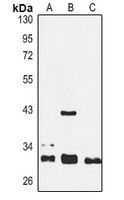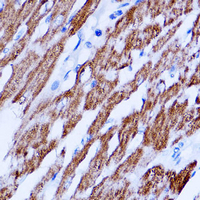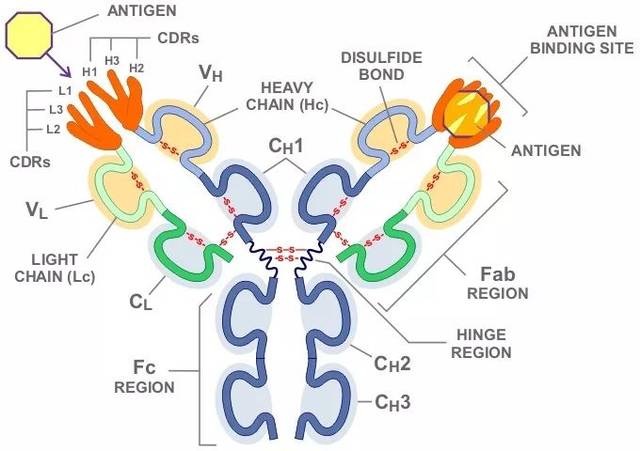Product Name :
SIRT3 polyclonal antibody Background :
The Silent Information Regulator (SIR2) family of genes is a highly conserved group of genes that encode nicotinamide adenine dinucleotide (NAD)-dependent protein deacetylases, also known as Class III histone deacetylases. The first discovered and best characterized of these genes is Saccharomyces cerevisiae Sir2, which is involved in silencing of mating type loci, telomere maintenance, DNA damage response and cell aging. SirT3, a mammalian homolog of Sir2, exists in human cells in two forms. The full-length 44 kDa protein localizes to the nucleus, while a processed 28 kDa protein lacking 142 amino terminal residues localizes exclusively to the mitochondria. The single murine form of SirT3 is equivalent to the processed human SirT3 protein. Full-length SirT3 protein is processed in the mitochondrial matrix by the mitochondrial matrix processing peptidase (MMP). Both full-length and processed forms of SirT3 are enzymatically active and de-acetylate histone H3 at Lys9 and histone H4 at Lys16 in vitro. SirT3 also de-acetylates Lys642 of acetyl-CoA synthetase 2 (AceCS2) and activates AceCS2 activity in the mitochondria. Restricted caloric intake, which is linked to increased lifespan in multiple organisms, increases SirT3 expression in white and brown adipocytes of obese mice, suggesting a role for SirT3 in aging. Two observations implicate SirT3 in the regulation of mitochondrial thermogenesis. First, exposure to cold temperatures increases SirT3 expression in brown adipocytes, while elevated temperatures reduce SirT3 expression. Second, over-expression of SirT3 results in increased levels of the mitochondrial uncoupling protein 1 (UCP1). SirT3 protein levels are also elevated in certain breast cancers. Product :
Liquid in 0.42% Potassium phosphate, 0.87% Sodium chloride, pH 7.3, 30% glycerol, and 0.01% sodium azide. Storage&Stability :
Store at 4°C short term. Aliquot and store at -20°C long term. Avoid freeze-thaw cycles. Specificity :
Recognizes endogenous levels of SIRT3 protein. Immunogen :
KLH-conjugated synthetic peptide encompassing a sequence within the C-term region of human SIRT3. The exact sequence is proprietary. Conjugate :
Unconjugated Modification :
Unmodification
SIRT3 polyclonal antibody Background :
The Silent Information Regulator (SIR2) family of genes is a highly conserved group of genes that encode nicotinamide adenine dinucleotide (NAD)-dependent protein deacetylases, also known as Class III histone deacetylases. The first discovered and best characterized of these genes is Saccharomyces cerevisiae Sir2, which is involved in silencing of mating type loci, telomere maintenance, DNA damage response and cell aging. SirT3, a mammalian homolog of Sir2, exists in human cells in two forms. The full-length 44 kDa protein localizes to the nucleus, while a processed 28 kDa protein lacking 142 amino terminal residues localizes exclusively to the mitochondria. The single murine form of SirT3 is equivalent to the processed human SirT3 protein. Full-length SirT3 protein is processed in the mitochondrial matrix by the mitochondrial matrix processing peptidase (MMP). Both full-length and processed forms of SirT3 are enzymatically active and de-acetylate histone H3 at Lys9 and histone H4 at Lys16 in vitro. SirT3 also de-acetylates Lys642 of acetyl-CoA synthetase 2 (AceCS2) and activates AceCS2 activity in the mitochondria. Restricted caloric intake, which is linked to increased lifespan in multiple organisms, increases SirT3 expression in white and brown adipocytes of obese mice, suggesting a role for SirT3 in aging. Two observations implicate SirT3 in the regulation of mitochondrial thermogenesis. First, exposure to cold temperatures increases SirT3 expression in brown adipocytes, while elevated temperatures reduce SirT3 expression. Second, over-expression of SirT3 results in increased levels of the mitochondrial uncoupling protein 1 (UCP1). SirT3 protein levels are also elevated in certain breast cancers. Product :
Liquid in 0.42% Potassium phosphate, 0.87% Sodium chloride, pH 7.3, 30% glycerol, and 0.01% sodium azide. Storage&Stability :
Store at 4°C short term. Aliquot and store at -20°C long term. Avoid freeze-thaw cycles. Specificity :
Recognizes endogenous levels of SIRT3 protein. Immunogen :
KLH-conjugated synthetic peptide encompassing a sequence within the C-term region of human SIRT3. The exact sequence is proprietary. Conjugate :
Unconjugated Modification :
Unmodification
-
 Western blot analysis of SIRT3 expression in 22RV1 (A), SW620 (B), MCF7 (C) whole cell lysates.
Western blot analysis of SIRT3 expression in 22RV1 (A), SW620 (B), MCF7 (C) whole cell lysates. -
 Immunohistochemical analysis of SIRT3 staining in rat heart formalin fixed paraffin embedded tissue section. The section was pre-treated using heat mediated antigen retrieval with sodium citrate buffer (pH 6.0). The section was then incubated with the antibody at room temperature and detected using an HRP conjugated compact polymer system. DAB was used as the chromogen. The section was then counterstained with haematoxylin and mounted with DPX.
Immunohistochemical analysis of SIRT3 staining in rat heart formalin fixed paraffin embedded tissue section. The section was pre-treated using heat mediated antigen retrieval with sodium citrate buffer (pH 6.0). The section was then incubated with the antibody at room temperature and detected using an HRP conjugated compact polymer system. DAB was used as the chromogen. The section was then counterstained with haematoxylin and mounted with DPX.
Bioworld Biotech only provide peptides for our antibodies and do not provide additional peptide customization services.
Price/Size :
USD 368/1mg/vial
Tips:
For phospho antibody, we provide phospho peptide(0.5mg) and non-phospho peptide(0.5mg).Describe :
Blocking peptides are peptides that bind specifically to the target antibody and block antibody binding. These peptide usually contains the epitope recognized by the antibody. Antibodies bound to the blocking peptide no longer bind to the epitope on the target protein. This mechanism is useful when non-specific binding is an issue, for example, in Western blotting (WB) and Immunohistochemistry (IHC). By comparing the staining from the blocked antibody versus the antibody alone, one can see which staining is specific; Specific binding will be absent from the western blot or IHC performed with the neutralized antibody.Formula:
Synthetic peptide was lyophilized with 100% acetonitrile and is supplied as a powder. Reconstitute with 0.1 ml DI water for a final concentration of 10 mg/ml.The purity is >90%,tested by HPLC and MS.
Storage:
The freeze-dried powder is more stable. For short time at 2-8°C. For long term storage store at -20°C.
Note :
This product is for research use only (RUO only). Not for use in diagnostic or therapeutic procedures.
 SIRT3 polyclonal antibody
SIRT3 polyclonal antibody  Datasheet
Datasheet COA
COA MSDS
MSDS SHIP
SHIP